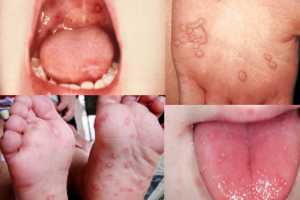Author: Rachel Bridwell, MD (@rebridwell, EM Resident Physician, SAUSHEC / San Antonio, TX) // Reviewed by: Brit Long, MD (@long_brit, EM Attending Physician, San Antonio, TX) and Alex Koyfman, MD (@EMHighAK, EM Attending Physician, UTSW / Parkland Memorial Hospital)
Welcome to EM@3AM, an emDOCs series designed to foster your working knowledge by providing an expedited review of clinical basics. We’ll keep it short, while you keep that EM brain sharp.
A 67-year-old female with a history of acute lymphoblastic leukemia comes into the ED for weakness and fatigue, stating her oncologist sent her for her semi-regular transfusion. From review of the EMR, her hemoglobin in 5.9 mg/dL and her platelet count was 1,000 cells/uL. A transfusion of platelets was initiated, though within approximately 1 hour of starting the transfusion, the patient became acutely short of breath and stated she was having severe difficulty breathing.
Triage vital signs (VS): BP 112/71, HR 129, T 99.1 F, RR 40, SpO2 91% on 15L non-rebreather. She is in distress with rhonchi bilaterally. Her skin is warm.
What’s the next step in your evaluation and treatment?
Answer: Transfusion Related Acute Lung Injury (TRALI)1-19
Epidemiology:
-
- Incidence as high as 1 in 1,333-1,500 per units transfused, though generally thought to be underrecognized and increasing in incidence, as very similar presentation to ARDS1,2
- Longer duration and high numbers of mechanical ventilation3
- Mortality estimates 5-53% though vary widely and are higher in North America3–5
- Leading cause of transfusion-associated fatalities6
- Patient risk factors for TRALI2,3,7–10:
- Hematologic malignancy
- ESRD
- Increased age
- Chronic alcohol abuse
- Massive transfusion
- Postpartum hemorrhage
- End stage liver disease
- Active smoker
- Positive fluid balance
- Cardiac surgery
- Transfusion risk factors9:
- FFP most implicated component4
- High volume female plasma or whole blood
- WBC Antigens in parous female donor population approximately 20-26%11
- High volume of HLA class II antibody
- High volume of cognate anti-HNA antibody
- Etiology is postulated to be a two hit event:12,13
- Hit 1: innate patient factor which generated neutrophils to adhere to pulmonary endothelium after priming
- Hit 2: Transfusion activates these primed neutrophils, increasing capillary permeability
- Incidence as high as 1 in 1,333-1,500 per units transfused, though generally thought to be underrecognized and increasing in incidence, as very similar presentation to ARDS1,2
Clinical Presentation:
-
- Diagnostic criteria:6
- Onset within 6 hours of transfusion
- PAO2/FiO2 <300 regardless of PEEP or oxygen saturation
- Chest radiograph with bilateral infiltrates on anterior view
- Pulmonary artery occlusion pressure <18 mm Hg and no evidence of left atrial hypertension
- i.e. non-cardiac etiology
- Low suspicion for ARDS
- Diagnostic criteria:6
Evaluation:
-
- Assess ABCs and obtain VS to include manually counted respiratory rate
- Tachypnea, tachycardia, hypoxia +/- fever
- Perform a complete physical examination
- Pink or yellow frothy sputum from oropharynx
- Pulmonary: Rhonchorous breath sounds, rales, decreased breath sounds4
- Check skin for petechiae and urticaria for other transfusion related issues
- Assess ABCs and obtain VS to include manually counted respiratory rate
Treatment:
-
- ABCs:
- If transfusion is still ongoing, stop the transfusion
- Airway and oxygenation support often required for these patients, which respond to NIPPV prior to consideration of invasive ventilator support14
- Mitigation of barotrauma is important—maintain lower peak pressures14
- Judicious fluid resuscitation is key, diuretics are not helpful in this patient14
- Exclude cardiac etiology with echocardiogram to confirm diagnosis
- Corticosteroids:
- Steroids reduced mortality, ICU free days, improved PaO2/FiO24,15
- Animal models demonstrated reduced IL-6 levels with steroids16
- Limited data from small trials, case series
- Disposition: Admit to ICU
- High rates of intubation in this population 70-90%12
- Discuss with blood bank/hematology for immunologic work-up
- Anti-HLA I, anti-HLA II, anti-HNA antibodies are most common17
- TRALI commonly due to donor derived antibodies to Anti-HLA II rather than Anti-HLA I, which are absorbed by recipient platelets17,18
- Anti-HLA I, anti-HLA II, anti-HNA antibodies are most common17
- Consideration of leukoreduction for future transfusion
- Reduction of TRALI status post leukoreduction19
- ABCs:
Pearls:
-
- Underrecognized in population receiving transfusion has presents similarly to ARDS
- Common in cardiac surgery patients
- More common in donor products from parous female donor in apheresis components
- Occurs within 6 hours of transfusion, pulmonary infiltrates in the absence of cardiac dysfunction
- High rates of intubation in this population, requiring barotrauma mitigation
- Potential benefit with steroids
Further Reading:
FOAM resources
LITFL: https://litfl.com/trali/
emDocs – http://www.emdocs.net/severe-transfusion-reactions-ed-focused-management/
References
- Müller MCA, Van Stein D, Binnekade JM, Van Rhenen DJ, Vlaar APJ. Low-risk transfusion-related acute lung injury donor strategies and the impact on the onset of transfusion-related acute lung injury: A meta-analysis. Transfusion. 2015;55(1):164-175. doi:10.1111/trf.12816
- Silliman CC, Boshkov LK, Mehdizadehkashi Z, et al. Transfusion-related acute lung injury: Epidemiology and a prospective analysis of etiologic factors. Blood. 2003;101(2):454-462. doi:10.1182/blood-2002-03-0958
- Vlaar APJ, Binnekade JM, Prins D, et al. Risk factors and outcome of transfusion-related acute lung injury in the critically ill: A nested case-control study. Crit Care Med. 2010;38(3):771-778. doi:10.1097/CCM.0b013e3181cc4d4b
- Wallis JP, Lubenko A, Wells AW, Chapman CE. Single hospital experience of TRALI. Transfusion. 2003;43(8):1053-1059. doi:10.1046/j.1537-2995.2003.00466.x
- Moore SB. Transfusion-related acute lung injury (TRALI): Clinical presentation, treatment, and prognosis. Crit Care Med. 2006;34(5 SUPPL.). doi:10.1097/01.CCM.0000214312.20718.3E
- Feng X, Patil AR, Ong M. A Case Report of Mild TRALI and Literature Review. Am J Clin Pathol. 2019;152(Supplement_1):S90-S91. doi:10.1093/ajcp/aqz117.014
- Vlaar APJ, Hofstra JJ, Determann RM, et al. The incidence, risk factors, and outcome of transfusion-related acute lung injury in a cohort of cardiac surgery patients: A prospective nested case-control study. Blood. 2011;117(16):4218-4225. doi:10.1182/blood-2010-10-313973
- Benson AB, Austin GL, Berg M, et al. Transfusion-related acute lung injury in ICU patients admitted with gastrointestinal bleeding. Intensive Care Med. 2010;36(10):1710-1717. doi:10.1007/s00134-010-1954-x
- Toy P, Gajic O, Bacchetti P, et al. Transfusion-related acute lung injury: Incidence and risk factors. Blood. 2012;119(7):1757-1767. doi:10.1182/blood-2011-08-370932
- Andreu G, Boudjedir K, Muller JY, et al. Analysis of Transfusion-Related Acute Lung Injury and Possible Transfusion-Related Acute Lung Injury Reported to the French Hemovigilance Network From 2007 to 2013. Transfus Med Rev. 2018;32(1):16-27. doi:10.1016/j.tmrv.2017.07.001
- Densmore TL, Goodnough LT, Ali S, Dynis M, Chaplin H. Prevalence of HLA sensitization in female apheresis donors. Transfusion. 1999;39(1):103-106. doi:10.1046/j.1537-2995.1999.39199116901.x
- Vlaar APJ, Juffermans NP. Transfusion-related acute lung injury: A clinical review. Lancet. 2013;382(9896):984-994. doi:10.1016/S0140-6736(12)62197-7
- Silliman CC. The two-event model of transfusion-related acute lung injury. Crit Care Med. 2006;34(5 SUPPL.). doi:10.1097/01.CCM.0000214292.62276.8E
- Kuldanek SA, Kelher M, Silliman CC. Risk factors, management and prevention of transfusion-related acute lung injury: a comprehensive update. Expert Rev Hematol. 2019;12(9):773-785. doi:10.1080/17474086.2019.1640599
- Yang ZG, Lei XL, Li XL. Early application of low-dose glucocorticoid improves acute respiratory distress syndrome: A meta-analysis of randomized controlled trials. Exp Ther Med. 2017;13(4):1215-1224. doi:10.3892/etm.2017.4154
- Müller MCA, Tuinman PR, Van Der Sluijs KF, et al. Methylprednisolone fails to attenuate lung injury in a mouse model of transfusion related acute lung injury. Transfusion. 2014;54(4):996-1001. doi:10.1111/trf.12394
- Bierling P, Bux J, Curtis B, et al. Recommendations of the ISBT Working party on granulocyte immunobiology for leucocyte antibody screening in the investigation and prevention of antibody-mediated transfusion-related acute lung injury. Vox Sang. 2009;96(3):266-269. doi:10.1111/j.1423-0410.2008.01144.x
- Kao KJ, Scornik JC, Riley WJ, McQueen CF. Association between HLA phenotype and HLA concentration in plasma or platelets. Hum Immunol. 1988;21(2):115-124. doi:10.1016/0198-8859(88)90086-9
- Blumberg N, Heal JM, Gettings KF, et al. An association between decreased cardiopulmonary complications (transfusion-related acute lung injury and transfusion-associated circulatory overload) and implementation of universal leukoreduction of blood transfusions. Transfusion. 2010;50(12):2738-2744. doi:10.1111/j.1537-2995.2010.02748.x







